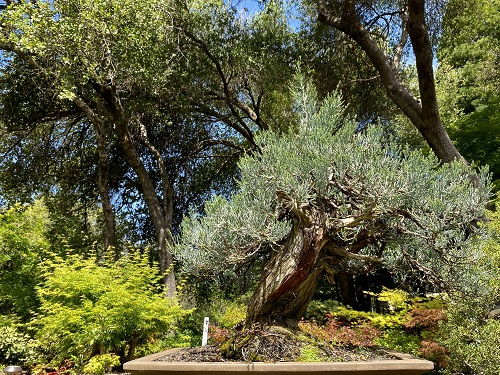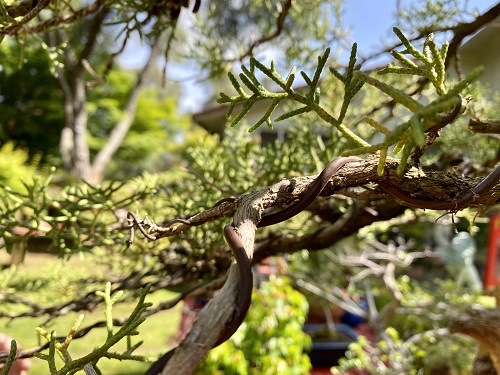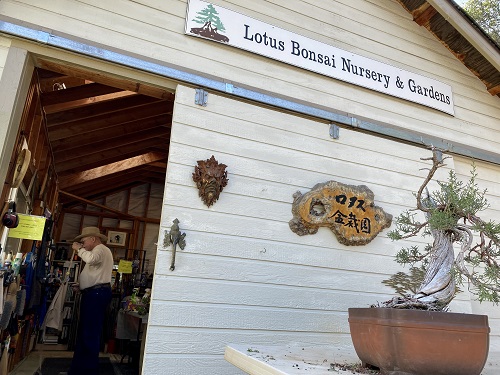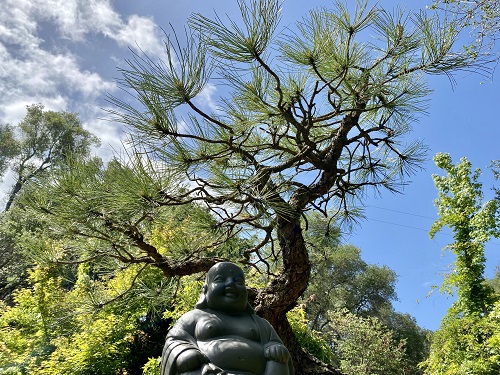Searching for Bonsai on California’s National Forests: “Every Tree Has a Story”

Sierra Juniper bonsai from the Tahoe National Forest. Lotus Bonsai Nursery & Gardens, Placerville, California
Californians love the ancient practice of bonsai – its popularity bolstered by 65 bonsai clubs and societies throughout the state. Originating in China more than 2,000 years ago, the art of growing trees in a tray from seeds or cuttings is often paired with yamadori, the collecting of wild trees from the mountains. The Forest Service supports these traditions with special use permits that allow a bit of the forest to come into towns and cities.
National forests offer an excellent place to look for trees shaped by natural forces. Ideal specimens – twisted and stunted by strong winds and dry terrain – are often found in the Krummholz, a narrow band of forest at elevations of 8,000 to 9,000 feet. Donner Summit on the Tahoe National Forest and Carson Pass on the Eldorado National Forest offer access to this High Sierra terrain.
“Every tree has a story,” explains Jay Miya, who practices yamadori further south and east on the Inyo National Forest. “We’re looking for character. We’re looking for struggle. We walk a lot of windy ridges. We want to show the effects of the environment on the tree.”

Wire gently wrapped around a bonsai’s branches to give it curvature. Lotus Bonsai Nursery & Gardens, Placerville, California.
Miya learned how to spot bonsai from his father Shig Miya – who comes from a generation of Issei, or Japanese immigrant, gardeners practicing bonsai and Zen-garden design for clients. Now a centenarian, Miya’s father still teaches bonsai classes at the Marina del Rey bonsai club.
“There is an etiquette to collecting,'' Miya explains. “You want to leave the land looking like you and the tree were never there. The responsibility makes you humble.” Miya finds the requirement of permits and policies for collecting trees from public lands creates “opportunity with constraints.”
For over three decades Scott Kusumoto, a forester on the Mammoth Ranger District of the Inyo National Forest, regularly issues permits for all kinds of forest products including bonsai. The Forest Products Removal Permit application (FS-2400-1) allows an individual to collect three trees for $7.50 per tree with a $22.50 minimum fee.

Utah Juniper bonsai from the Inyo National Forest in front of Scott Chadd’s workshop at the Lotus Bonsai Nursery & Gardens, Placerville, California.
“The most popular trees for bonsai are Utah junipers, Sierra junipers, and Lodgepole pines,” Kusumoto shares. “Other species include Western white pine and Mountain hemlock and even the occasional sagebrush.”
Every year Scott Chadd, who runs the Lotus Bonsai Nursery and Gardens in Placerville, acquires permits to collect trees from national forest land. In his former fast-paced career as the county and city public works director, Chadd found bonsai to be a Zen practice. He has been doing it for over fifty years.
“The world just disappears,” he says. “Now I teach it to people who are suffering from stress.” When he takes students to practice bonsai, he shows them how to be good stewards of the forest throughout the process, carefully covering their holes and letting forest managers know if they uncover any cultural artifacts.

Ponderosa Pine bonsai from the Tahoe National Forest. Lotus Bonsai Nursery & Gardens, Placerville, California
The visual impact is the most important feature of a bonsai. Chadd learned this from bonsai master George Yamasaki who showed him how to gather the suiseki, or the stones, for bonsai. Chadd invites everyone to suspend disbelief and focus on the future, what the tree is becoming. A single bonsai “can be the work of a lifetime.”
“It is,” he says, “a very Asian way of looking at the world.”
For those who go to the mountains and national forests to find, transplant, prune and care for bonsai, remember that the process is as important as the product. As Chadd says, “The most important thing is to find pleasure.”
Moving Zen: Bonsai & R5 National Forests from Pacific Southwest Region on Vimeo.

